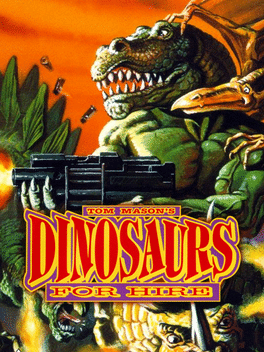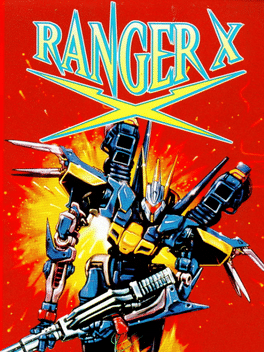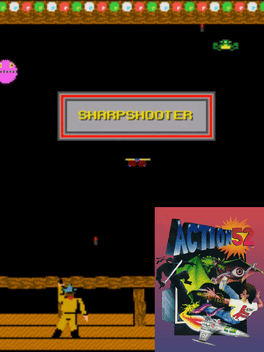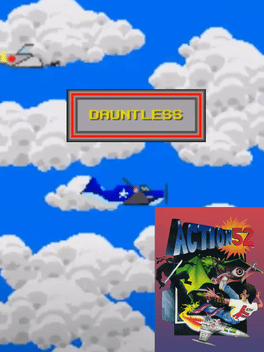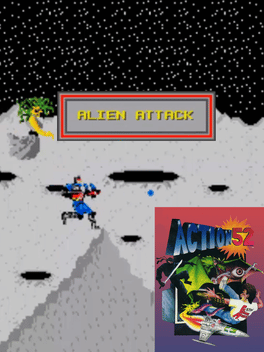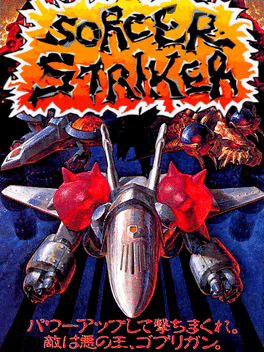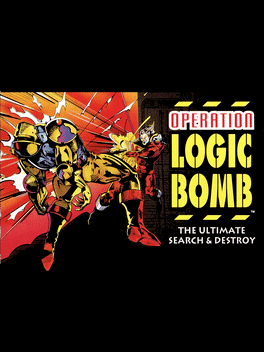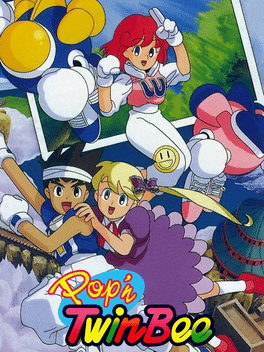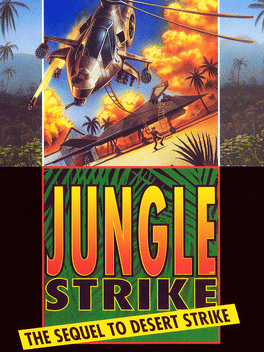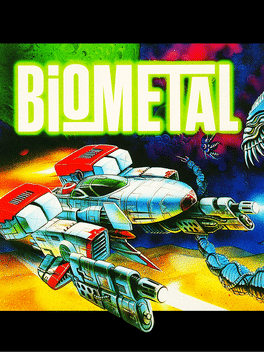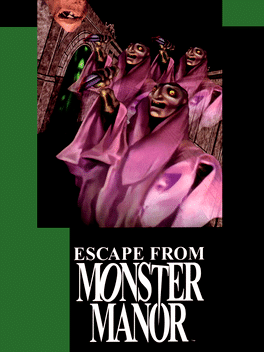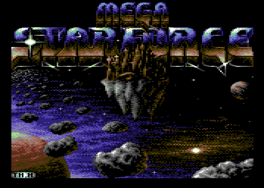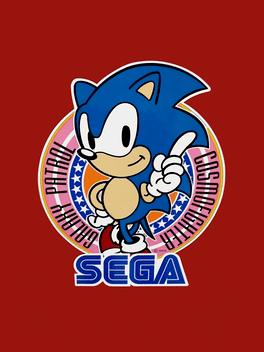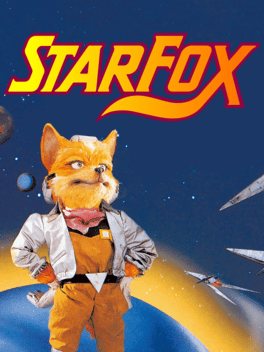New Wii Games - Page 408
-
Tom Mason's Dinosaurs for Hire
1993
star 6.9Unknown monsters and weird robotic creatures attack the Earth. For some reason, the only ones who can stop the invasion are the three Dinosaurs for Hire: Archie, a tyrannosaurus rex and their leader; the triceratops Lorenzo, lover of fine food, fine wine, and fine clothes, and the one-eyed, unpredictable stegosaurus Reese. Each dino has its own strengths and weaknesses. You guide the dinosaur of your choice through the platform levels of the game. You are equipped with a gun: tons of enemies will attack you from all the sides, so your best bet will be walking with the fire button pressed down. You can shoot to all the directions and also engage in melee combat when the enemy is too close. Each level has a boss enemy waiting for you in the end. There is also a cooperative two-player mode. -
Ranger X
1993
Ranger X
1993
star 8.8Engage in airborne combat with jump-jets and weapons of incredible power or link up with your cyber cycle for high speed ground attacks. Each step inches you closer to your goal and the fight of your life. You are Ranger X... A mysterious lone warrior who has risen from the ashes to return peace and justice to a failed society. Eight post-apocalyptic levels of high-intensity action! Monstrous mechanical bosses await your every move. Use jump-jets to attack by air or transform into the Super Cyber Cycle and roll to victory! -
Toys
1993
Toys
1993
Toys (also known as Toys: Let the Toy Wars Begin!) is an action video game for the Super NES and Sega Genesis released in 1993. The game is based on the 1992 film Toys starring Robin Williams. Chaos has been spread at a toy factory that must be stopped by the player. -
Air Assault
1993
Air Assault
1993
Air Assault is a 2D up-scrolling shoot 'em up game where you take control of fighter. The game is similar to Air Duel. You have to tward the evil plans of an organization called the Fourth empire over the span of eight stages. As you make progress and fight of various tanks, flying crafts, ships, static guns and bosses power-ups come available. Power-ups can be collected from capsules. Four types of guns are available: Balkan gun (broad strait shooting gun), Wing gun (broad arc shooting gun), graviton laser (strait narrow beam) and grenade (all direction gun). Missiles include the strait megaton missile and a homing missile. There is also a bomb that clears the entire screen. The game can be played solo or with a friend. -
Sharpshooter
1993
Sharpshooter
1993
SHARPSHOOTER is one of the listed mini game in Action 52. Action 52 was released in 1993 for SEGA Genesis. -
Dauntless
1993
Dauntless
1993
Dauntless was one of the many games bundled in Action 52, an unlicensed multicart video game compilation developed by Active Enterprises. -
Alien Attack
1993
Alien Attack
1993
The 17th Title included in Action 32 for Mega Drive/Genesis. A belt-scrolling shooter in which the player must proceed to the right, while defeating the aliens who are trying to take the world. -
Slap Fight MD
1993
Slap Fight MD
1993
Slap Fight MD (スラップファイト) is a 1993 shoot-'em-up game developed by Toaplan and MNM Software for the Sega Mega Drive and published by Tengen exclusively in Japan and South Korea. Two games are available: a port of Toaplan's 1986 arcade shoot-'em-up Slap Fight with the choice to use either remastered music or the original sound, and a separate game called Slap Fight MD, that has the same gameplay mechanics but new art, levels, weapons, and music (composed by Yuzo Koshiro). The option to switch between Slap Fight and Slap Fight MD is in the Options menu under "Game Mode," with Normal enabling Slap Fight and Special enabling Slap Fight MD. -
Sorcer Striker
1993
Sorcer Striker
1993
Sorcer Striker, released in Japan as Mahou Daisakusen is a 1993 medieval-themed scrolling shooter arcade game developed and published by Raizing (now known as Eighting) , and later ported to the X68000 and FM-Towns computers and the EZweb mobile phones. It is the first game in the Mahou Daisakusen trilogy, which includes Kingdom Grandprix and Dimahoo. -
Operation Logic Bomb
1993
Operation Logic Bomb
1993
star 6The best scientists in the world have been working for years on the Subspace Particle Transfer Project, a process that uses subspace transporters to dematerialize an object, then instantly rematerializes it at another location. Short distance transfers of individuals have also been successful, and the scientists were about to begin long-range transport experiments. However, contact with the research laboratory has been lost. Someone - or something - has taken over the facility and shut down all outside communications. There is no information about the intruders or their capabilities... no one has entered the facility and returned to tell about it. Plans for a final assault have been prepared and if it fails, there will be no choice but to destroy the entire installation. Agent Logan, who has been fitted with bioelectronic implants that give him superior strength, reflexes, and anlystical abilities, has been briefed on all aspects of the mission. Now it's up to him to infiltrate the lab, neutralize the intruders, a -
Lords of Thunder
1993
Lords of Thunder
1993
star 7.3In the once peaceful land of Mistral, legend holds of a brave knight named Drak who has sealed an evil god named Deoric beneath the six continents of the land. However, peace never lasts. The Garuda Empire has invaded the lands of Mistral, and the six Dark Generals, led by Sornbul, have conquered the continents. Sornbul's ambition is nothing less than to resurrect Deoric and plunge the land into chaos. Duran, descendant of Drak, is the only one who can stop the Garuda Empire's mad plan, and with the power of Drak's mystic armors, he heads off to stop Sornbul at any cost. -
Sengoku Ace
1993
Sengoku Ace
1993
Sengoku Ace, fully titled Sengoku Ace: Tengai Episode I and also known as Samurai Aces in the English version, is a vertically-scrolling shoot 'em up video game originally released in the arcades by Psikyo in 1993. The first game by Psikyo, Sengoku Ace was designed by Shin Nakamura, the creator of Aero Fighters (Sonic Wings) and the company's founder. The game features 21 endings, different for various characters and 2-player pairings. -
Blue Hawk
1993
-
Pop'n TwinBee
1993
-
Jungle Strike
1993
Jungle Strike
1993
star 6.8A sequel to Desert Strike: Return to the Gulf (a best-seller released the previous year) and the second instalment in the Strike series. Jungle Strike retained its predecessor's core mechanics and expanded on the model with additional vehicles and settings. The game was well received by most critics upon release, with the Mega Drive release receiving critical acclaim from their respective reviewers. Publications praised its gameplay, strategy, design, controls and graphics, although there were some complaints regarding the interface and difficulty. -
BioMetal
1993
BioMetal
1993
BioMetal is a side-scrolling shooter game. Their are two pairs, one for lasers and the other for missiles, of three upgrades for your weapons. The war that divided the galaxy and used all it's resources has ended. A fleet was sent on a mission to find more natural resources. They never returned. Their last transmission reveals that the enemy' created one last experiment. This experiment is a combination of the aggressive nature of animals combined with the efficiency of machines. These creatures were named BioMetal. The MF-92GX Halbard mothership has been assigned to destroy the threat before they can not be stopped. You are piloting the MF-92GX Halbard fighter that is equipped with the experimental Gel Analog Mutant weapon. The Gel is charged up on the ship and can be used to surround the ship as a protective shield or be thrown at the enemy forces. -
Escape from Monster Manor
1993
The undead have been unleashed upon the world. Only a holy talisman can destroy them, but it has been broken into pieces and hidden in Monster Manor. Now you must venture into the cursed mansion and find the pieces so that humanity may be saved. The game is a first-person-shooter where you have to destroy enemies like ghosts, skeletons and zombies using your only gun. Items scattered around the house include health packs, gun energy, treasure and keys that are used to open doors that block your way to the next talisman piece. The game has twelve levels. -
Mega Starforce: Return to the Great Star
1993
The attackers from outer space are back. This time, however, they are stronger and tactically better prepared to bring the world one step closer to its doom. Practically, this means blasting everything movable into little pieces and collecting bonus items. In higher levels, the enemies become faster and more aggressive. At the same time, their bombing frequency also increases. There are also several different enemies that break away from the formations and attack the player. -
SegaSonic Cosmo Fighter
1993
SegaSonic Cosmo Fighter Galaxy Patrol is a 2D shoot'em up arcade ride viewed from a top-down perspective. The family-sized cabinet is designed like a spaceship with the feature of the cabinet shaking during the ride. The cabinet board has two buttons for weapons to fire projectiles or homing rockets and a lever labeled "SPEED UP", which tilts the entire ride. There is also a regular joystick on the left side of the board that maneuvers the ship which can also tilt the cabinet. After inserting the coin, Sonic gives a speech to the player and hops into the red spaceship which gets launched from the earth's galaxy patrol station into space. Right after, Dr. Eggman appears in a small space pod to deploy bombs and obstacles at Sonic. Destroying bombs and obstacles rewards the player with stars. After arriving at the space station, Eggman will then attack with his space pod by firing projectiles or homing at the Sonic's spaceship after landing one of three hits. If the player defeats Eggman, doctor pulls back and return -
Star Fox
1993
Star Fox
1993
star 7.6Star Fox, released as Starwing in Europe, is a 1993 rail shooter video game developed and published by Nintendo, with assistance from Argonaut Software, for the Super Nintendo Entertainment System. The first game in the Star Fox series, Star Fox follows Fox McCloud and the rest of the Star Fox team defending their homeworld of Corneria against the attacking forces of Andross.
